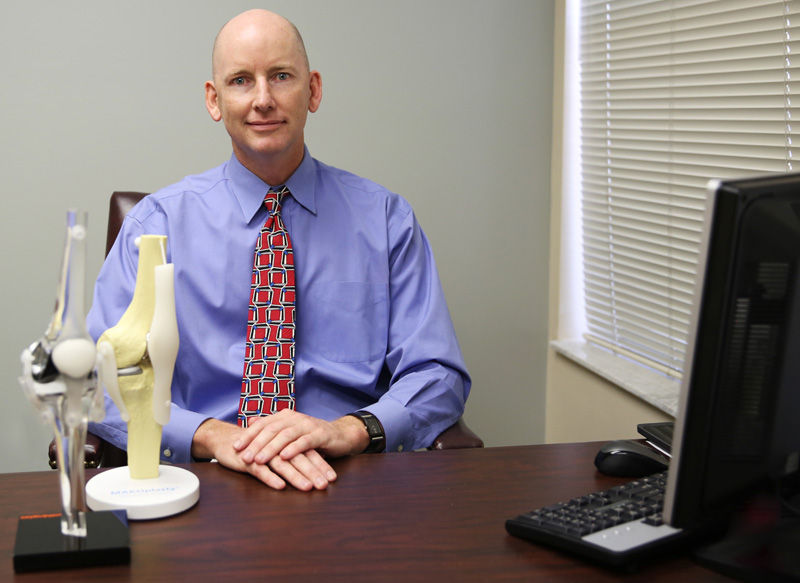“Back in the day” joint replacement surgery – hip and knee being the most common – meant total joint replacement, a complicated major surgical procedure that meant a good amount of post-operative pain (or, in medical parlance, “discomfort”) and a months-long recovery period.
That was then and this is now – an exciting time in the field of medical technology, in which amazing advancements across the broad spectrum of specialties often result in far less invasive surgery, which equals less blood loss, reduced pain, shorter hospital stays and shorter recovery periods.
Sebastian orthopedic surgeon Anthony Ware, a native of Massachusetts who completed his undergraduate studies at UMass in Amherst and medical school at the UMass campus in Worcester, handles arthroscopic knee, shoulder and ankle surgery; hand and wrist issues including carpal tunnel syndrome; foot and ankle fractures and dysfunctions; sports injuries, and partial and total joint replacements.
In 1993, Ware moved to Jacksonville to completed two years’ residency in general surgery and four in orthopedic surgery, followed by a one-year fellowship at the Mayo Clinic’s Jacksonville facility.
Ware had a practice in the Brevard area for 14 years in association with Wuesthoff Hospital and Holmes Regional Medical Center in Melbourne before relocating to Sebastian early this year.
With models illustrating partial and total knee replacements, Ware explained the advancements in joint replacement procedures and who can benefit from such surgeries. Partial joint replacement capability was a medical breakthrough in 2006, but didn’t become “mainstream” until around 2011.
The decision to perform partial rather than total joint replacement is based on whether the damage is isolated, which would indicate a partial replacement, or diffuse, encompassing the entire joint. X-rays are employed to determine this.
Age is another factor. A younger patient, between 40 and 50, might choose to have a partial initially, then convert to a total later, as conditions indicate. In an older patient, a one-time total implant is often best.
Those who have an active athletic lifestyle or hold certain jobs can increase the risk of damage to shoulders, hip, back, neck or knee. Ironically, this group shares the risk with those at the other end of the spectrum: elderly individuals often suffer joint damage from falls brought on by such aging events as dizziness and balance.
Arthritis is another common cause of joint damage and some individuals may have a genetic predisposition.
Then, of course, in areas such as the Treasure Coast, doctors see lots of joint injuries relating to golf. Locally, the average age of joint replacement patients, Ware estimates, is between 60 and 80.
A cutting edge procedure which Ware can perform at Sebastian River Medical Center is robotic arm-guided MAKOplasty partial knee implant surgery, a new technology that enables significantly quicker recovery, a shorter hospital stay and a smaller incision with less blood loss. (Ware performed Brevard County’s first robotic arm-guided knee surgery.)
A major advantage of robotic-assisted implant surgery, Ware says, is “the precision with which the implant can be placed – within a millimeter.”
Before the surgery, he explains, a CAT scan of the knee is taken, from which a virtual three-dimensional model is created, allowing the surgeon to determine the size of the implant best suited to the individual patient, thus removing only the smallest possible amount of bone, and resulting in the best range of motion.
The implants themselves are made of surgical stainless steel and come in eight sizes so they can be accurately fitted to each patient. With partial implant surgery, the ligaments are not removed, allowing for a more natural feeling. Recovery from partial surgery typically takes three to four weeks, compared to 10 to12 weeks with total joint replacement.
To further ensure exact size and location, Ware explained, “just before the surgery, while the patient is on the (operating) table – like the carpenter’s ‘measure-twice, cut once’ rule – we make reference points on the patient’s knee, and the computer checks the pre-op plans so you still have time to adjust the position, via the computer, before locking in the plan and sweeping in the robotic arm,” which then uses a delicate burr tool to remove the bone.
During the removal of the bone, three safeguards are used. On the computer screen, the area of bone removal is shown in green. Should the burr tool move outside the boundary, the green changes to red, a beep sounds and the machine stops.
Ware says he continues to find our area a great place not only to work but also to live.

